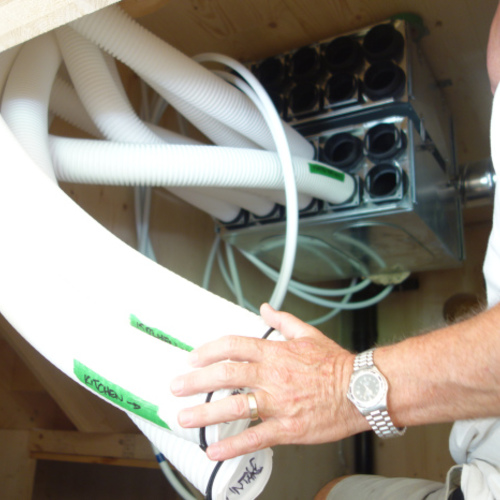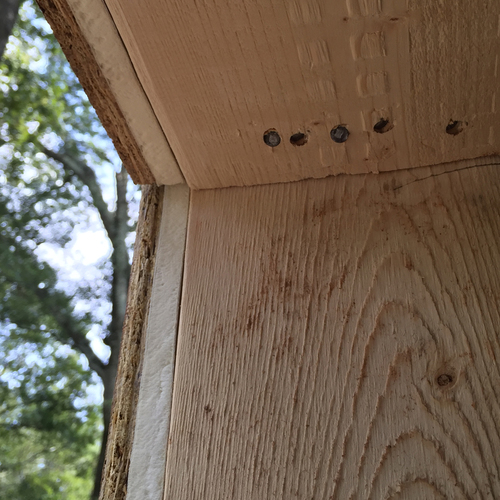Image Credit: All photos: Carl Seville
Image Credit: All photos: Carl Seville Drywall and floors are installed. Trim work will start soon. Windows are from Windsor: wood windows clad with aluminum on the exterior. The siding and trim are all Boral Tru-Exterior with the exception of the flat panels at the top of the walls, the lookouts, and bed moulding at the soffit. Overall a very low-maintenance exterior. The blue tape on the ERV intake is left over from my pre-insulation blower door test (1.5 ach50 at the time). Shaping up nicely and fits in well with the historic neighborhood. When we're done, few people will even realize it isn't an old house.
Our home construction project is over the hump: drywall and flooring have been installed, exterior trim is wrapping up, and interior trim, cabinets, and tile will be starting soon.
Although things are generally going quite well, and while I am happy with the house, I am not enjoying the process very much. Even after 25 years as a contractor, I don’t deal well with the stress of coordinating dozens of subcontractors and suppliers. Materials don’t arrive when promised, workers don’t finish on schedule, and managing different trades in the house at the same time creates tensions.
All this adds up to a lot of lost sleep at night and waiting around for people to show up and answer calls and emails during the day. I know I will end up with a superior product in the end, but the path there is taking its toll on my sanity.
New and recurring problems
The incompetent framing work continues to haunt us. The exterior trim crew is working diligently to correct out-of-level, out-of-plumb, and out-of-square construction, hiding a multitude of sins with skillful finish work. Few people will every notice the little details that will bother me, and luckily these are all cosmetic at this point and won’t affect the building performance.
Interior trim work will start soon. I believe we have addressed most of the issues inside, but we will only know once installation starts. With a little luck we won’t uncover any major problems.
One issue that I take full responsibility for was the drywall adhesive. I neglected to specify a low-VOC product, so when I first walked in the house when the hangers were working I was hit hard with the fumes from the glue they used.
Fortunately, it will dissipate quickly and is unlikely to have any long-lasting effects, but it would have been nice to use a less toxic product. Not being a full-time builder, I don’t have standard specs nor ongoing relationships with trade contractors. Armed with either, this problem could have been easily avoided.
Most green building programs provide points for low-VOC products. Some even require the use of all low-VOC sealants and adhesives in a project. This can be one of the most difficult tasks to accomplish considering how many different trades bring their own products on the jobsite.
Without a guard at the door, inspecting everything that arrives on site, it is challenging to keep all high-VOC products off the job. I have specified no added urea formaldehyde material for cabinets and closet shelf systems, and low- or zero-VOC paints and floor finishes. I’m still waiting for the specifications on some of those products. I plan on not being shocked at odors when I walk in the house again.
Looking inward
Other than a small scheduling snafu with drywall finishers and floor installers on site at the same time, the interior work is moving along well. I installed Owens Corning blown-in fiberglass insulation in the walls behind netting and fiberglass batts in most of the rim joists.
The installers did a good job over two long days, with my close supervision on the installation of the batts (after I caught them doing a typical Grade 3 cram-it-in-as-fast-as-they-can method). Luckily they were receptive to my instructions about cutting to fit around pipes and wires.
We wrapped up in the dark with headlamps lighting the way. Attic insulation will go in later — R-50 loose fill over the Zip Sheathing we installed on top of the second-floor ceiling joists. One minor issue in the attic is the vent baffles: although they are installed and are high enough to go over the top of the insulation, as installed, they don’t block off the soffit, so additional work will need to be done before we can insulate.
Luckily climate change is cooperating and giving us spring-like temperatures much of this winter. Except for a short cold snap that delayed the finishers before our current 70+ temperatures, drywall was installed and finished efficiently by a very professional crew. Two small electric space heaters kept the house from getting too cold for a few days, thanks to the tight and well-insulated envelope.
Wood floors are installed. Since the entire house is on a slab and I wanted site-finished wood, we installed plywood on the slab, nailed through the Polyguard Term vapor and termite barrier, which was then treated with Boracare. We had some nail pops that took some work to correct, but the floor went in well, and so far there are no noticeable squeaks or soft spots.
Interior doors and trim, ceramic tile, and cabinet installation all start soon, so I expect the activity and my stress level to rise along with the activity inside.
Moving out(side)
As exterior trim is wrapping up, we will finally have enough space on the site to start masonry and driveways. Thin veneer brick will be installed on the concrete foundation in order to avoid having a ledge extending out past the siding; a brick stoop will go in at the front door; a walkway will extend to the sidewalk; and short planter walls will be installed at the rear of the house.
The main driveway will be pervious concrete — necessary to comply with local impervious surface requirements — and pervious brick pavers will create a patio area that will double as a driveway to the carport.
If the weather and trade contractors cooperate, we’re hoping to wrap up construction and move in by early April. Since Decatur requires a green certification certificate to issue a Certificate of Occupancy, we will likely wrap up EarthCraft and NGBS certification quickly, and deal with the LEED certification later since that is a much slower process.
Weekly Newsletter
Get building science and energy efficiency advice, plus special offers, in your inbox.
















5 Comments
Fiberglass
Looking good, Carl. I remain concerned about airborne fibers from the fiberglass. I'm sure you considered this issue. What persuaded you that it wasn't going to be a problem?
Looking good !
I appreciate the honesty with regards to the various challenges you've encountered. Good perspective.
Fibers
Steve - All insulation has pros and cons, and I decided to give fiberglass a try to see how well the building would perform without having to resort to spray foam. Fiberglass is mostly an irritant, and by the time the house is complete and aired out, there won't be many if any fibers left floating around in the air as they will all be sealed into the drywall.
Do you have any concerns about condensation at rim joists only insulated with FG batts?
PJ Clem,
As Carl explained in an earlier blog, "Movin’ On Up," his house is built on a slab. There is no basement. There is no crawlspace.
The rim joists he's talking about are between the first floor and the second floor. If air movement is controlled, this type of rim joist is not subject to the rot problem sometimes encountered in basement rim joists -- especially in a warm climate like that of Atlanta, Georgia.
Log in or create an account to post a comment.
Sign up Log in